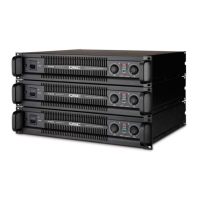PL3 Series Service Manual 29
TD-000274-00 Rev. A
2 Ohm Power and Short Circuit
Current Test
1. Connect a 2-ohm load resistance to channel 1’s output. Apply a
1.6 V rms, 1 kHz sine wave signal to channel 1’s XLR input.
2. Adjust the gain control to obtain 1250 watts of output power
(50 V rms). Verify that the THD is below 1%.
NOTE: adjust the variable autoformer to maintain the AC line
voltage at 120 V or 240 V during this test.
3. Turn the channel gain down 3 dB, to obtain output power of 625
watts (35.4 V rms). While the amplifier is producing power into
the load, apply a short circuit across the output.
4. Measure the AC line current; it should be no greater than 6 A
(120 V model) or 3 A (230 V model).
5. Remove the short. The channel’s output signal should immedi-
ately resume into the 2-ohm load as before, with no delay or
hangup.
6. Repeat steps 1 through 5 for channel 2.
Thermal Test
1. Set the amplifier gain controls to minimum and apply a 1.6Vrms, 1
kHz input signal to both channels. Note: set the Input Mode switch
in the PARALLEL position if only one input is available.
2. Apply a short across the output of each channel and turn the
amplifier gain controls to maximum. Clip LEDs should be on.
3. Measure AC line current; should be about 12 - 14 Aac for both
channels. As the amplifier gets hot, there will be some current drift
upwards. That’s normal.
4. Block the fan’s intake and verify the fan speed will ramp up from
low to high speed.
5. Run the test until thermal protection engages; the AC line current
will drop significantly to 1A.
6. Remove the short from the outputs and remove the block from the
fan’s intake.
7. Select 8 ohm load and allow the amplifier to fully recover from
thermal protection; verify output signal of each channel and fan
speed ramps down from high to low speed.
Output Noise Test
1. Connect an 8-ohm load resistance to channel 1’s output. Apply a
1.6 V rms, 1 kHz sine wave signal to amp channel 1’s XLR input.
2. Turn the amplifier gain controls to maximum. Set the analyzer’s
0 dB reference to this level.
3. Disconnect the input signal from the amplifier input and measure
the residual noise level produced into the load. The noise signal
should be at least 105 dB below the 0 dB reference.
4. Repeat steps 1 through 3 for channel 2.
Turn On/Turn Off Transient Test
1. Connect a loudspeaker to the output of each amplifier channel.
2. Disconnect any inputs from the amplifier.
3. Turn on the amplifier and listen for any transient or thump noises
during turn-on delay sequences.
4. Turn off the amplifier; all LEDs should turn off immediately.
Listen for any transient or thump noise at turn-off .
Quality Review
This completes the amplifier test procedure for this model. Inspect
the amplifier for mechanical defects. Inspect the solder connections.
Reassemble the amplifier and verify its operation prior to returning
the product to service.
2.5 PL325 Test and Calibration Procedure (continued)

